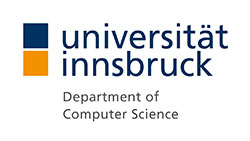Spreading excellence and disseminating the cutting edge results of our research and development efforts is crucial to our institute. Check for our educational offers for Bachelor, Master and PhD studies at the University of Innsbruck!
Semantic Grid: Extending Semantic Web Services infrastructure with Grid
Semantic Web Services have been envisioned as a layer of semantics on top of Web Services for dynamic discovery and execution in open Web like environment, which makes it a suitable candidate to be applied on Grid. Grid is an open, heterogeneous and dynamic environment where coordination and sharing of resources as well as creation of virtual organizations require flexibility and dynamism. Currently, flexibility and dynamism is very restricted in the Grid and requires human-intervention due to the lack of machine interpretable meta-information. Semantic Grid has been envisioned as next generation of current Grid infrastructure which will offer semantically enabled meta-information in the Grid. Research on Semantic Grid has gained momentum in the last few years and a number of efforts have been made to realize possible high-level Semantic Grid architectures. Several efforts have been made to apply the Semantic Web technologies over Grid in order to at least partially achieve the vision of Semantic Grid.
This thesis introduces a new approach towards achieving the Semantic Grid vision using Semantic Web Services based on the fact that the current Grid specifications have been made compliant with Web Services. Secondly, Semantic Web Services infrastructure (Conceptual Model – WSMO, Formal Language – WSML, and Execution Environment – WSMX) have been realized to provide a layer of Semantics on top of Web Services in order to achieve dynamic discovery, selection, composition, mediation and invocation of Web Services based on the semantically enriched descriptions. This thesis proposes that how the Semantic Web Services infrastructure can be extended towards Grid specifications to achieve the Semantic Grid vision. As a first step, it introduces the related state-of-the-art in the area of Web Services, Semantic Web Services and Grid Computing. It then provides a survey and analyzes the related Semantic Grid services approaches using AI, Agents and Semantic Web technologies for Grid. After that the thesis proposes a common system infrastructure for the related technologies (i.e. Semantic Web Services, Grid Computing and Intelligent Objects) called as GRISINO (Grid Semantics and Intelligent Objects) which acts as the basis of the motivation towards achieving Semantic Grid based on the extended Semantic Web Services infrastructure. It then proposes the extensions in Semantic Web Services infrastructure, i.e. Grid Service Modeling Ontology (GSMO) as extension of WSMO conceptual model, Grid Service Modeling Language (GSML) as extension of WSML formal language and finally Grid Service Execution Environment (GSMX) as extension of WSMX execution environment. The thesis also provides the implementation and evaluation based on test-cases, followed by conclusions and installation and development guide (in appendix section) prepared during the course of the thesis.
Contact person in charge.

